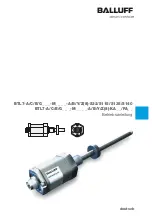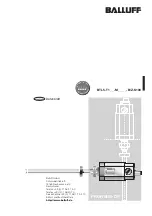
IM 01C22T01-01E
2-5
2. HART COMMUNICATOR OPERATION
2.3 Parameters
2.3.1 Parameter Usage and Selection
Before describing the procedure for setting parameters,
we present the following table showing how the
prameters are used and in what case.
NOTE
Do not turn off the transmitter as soon as HART
Communicator settings (sending) have been
made. If the transmitter is turned of less than 30
seconds after parameters have been set, the set
data will not be stored and the terminal returns
to previous settings.
Table 2.3.1 Parameter Usage and Selection
Memory
Transmitter
Display
HART output
Monitoring
Maintenance
Adjustment
T0201.EPS
Item
HART Communicator
Description
Page
Tag
Descriptor
Message
Date
Unit
LRV/URV
Apply values
Xfer fnctn
Damp
Low cut
Cut mode
Bi-dire mode
H
2
O Unit select
Snsr temp unit
Static pres unit
Display fnctn
Display mode
Engr disp range
Burst option
Burst mode
Poll addr
Auto poll
Pres
% rnge
A01 out
Snsr temp
Static pres
Engr display
Loop test
Self test
Status
A01 Alarm typ
Ext SW mode
Write protect
Enable write
New password
Zero trim
Lower/Upper sensor trim
D/A trim, Scaled D/A trim
Tag number, Up to 8 characters
Up to 16 characters
Up to 32 characters
xx/yy/zz
Set the calibration range by the keypad
Range for 4 to 20 mA DC signal is set with actual input applied.
Linear or Zero
Used to measure bi-directional flows.
at 4
°
C (39.2
°
F)/at 20
°
C (68
°
F)
Sets a unit for temperature displayed on the model 275.
Sets a unit for static pressure displayed on the model 275.
Engr unit/Engr disp LRV/Engr disp URV/Engr disp point.
Selection of the data to be sent continuously (Pres/% rnge/A01 out).
ON/OFF switching of burst mode.
Setting the polling address (1 to 15).
ON/OFF switching of multi-drop mode.
Pressure variable
% output variable
4 to 20 mA output variable
Sensor temperature
Static pressure
Displays output as on an LCD. settable in the engr disp range.
Display of the result of self-test, calibration of transmitter.
Display the status of 4 to 20 mA DC output when a failure
Display/set the external volume protect/permit for LRV (URV) setting.
Setting a new password.
Set the current input value to 0 kPa.
Adjust only measured pressure variable.
Adjust the output value at the points of 4 mA and 20 mA.
Engineering unit
Range
Output mode
Damping time constant
Output signal low cut
mode
Bi-direction flow
measurement mode
H
2
O unit selection
Unit for displayed
temperature
Unit for displayed static
pressure
Integral indicator display
mode
Integral indicator scale
Burst mode
Multi-drop mode
Test output
Self-diagnostics
Output when CPU error
has occurred
External volume
protect/permit
Software Write Protect
Zeroing
Sensor trim
Analog output trim
inH
2
O, inHG, ftH
2
O, mmH
2
O, mmHG, psi, bar, mbar, g/cm
2
, kg/cm
2
, Pa, kPa, MPa, torr, atm
Sets mode for output signal to “linear mode” (proportional to input differential pressure)
or to “Square root mode” (proportional to flow).
Adjust the output response speed for 4 to 20 mA DC. 0.2, 0.5, 1, 1.5, 2, 4, 6, 8, 16, 32
(sec)
Used mainly to stabilize output near 0 if output signal is the square root mode. Two
mode are available: forcing output to 0% for input below a specific value, or changing to
proportional output for input below a specific value.
Sets mode for integral indicator to “linear mode” (proportional to input differential
pressure) or to “Square root mode” (proportional to flow).
Set the following 5 types of integral indicator scale ranges and unit: “% scale indicator”,
“use set scale indicator”, “alternate indication of user set scale and % scale”, “input
pressure display” and “alternate indication of input pressure and % scale.
Used for loop checks. Output can be set freely from –5% to 110% in 1% step.
Check using the self-test command. If an error is detected, the corresponding message
is displayed.
Displays the permit/protect status of setting changes depending on communications.
Write protect status is released for 10 minutes when the password is entered.
P.2-7
P.2-8
P.2-9
P.2-10
P.2-19
P.2-12
P.2-10
P.2-10
P.2-16
P.2-11
P.2-12
P.2-13
P.2-14
P.2-19
P.1-2
P.2-17
—
—













































